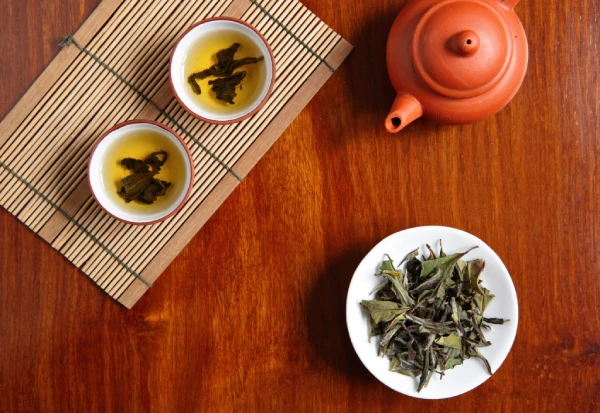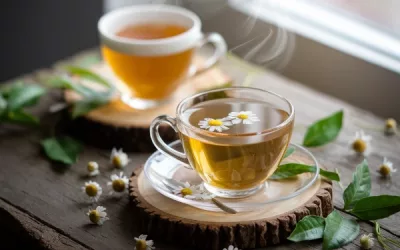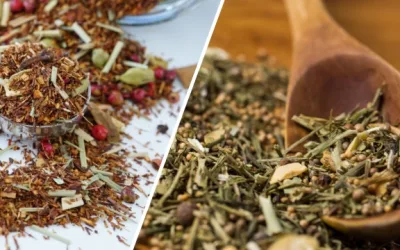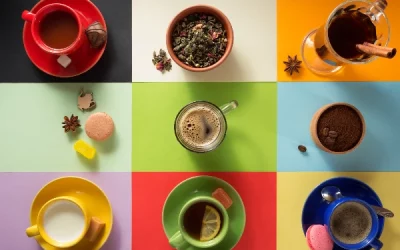Did you know that white tea is often considered the “delicate cousin” of green tea? Both are beloved for their distinct flavours and health benefits, yet they differ significantly in processing, caffeine content, and flavour profiles. As tea enthusiasts and health-conscious consumers alike seek to maximise the benefits of their brews, understanding these nuances becomes essential. This comprehensive guide will unravel the differences between white tea and green tea, exploring everything from brewing techniques to health advantages, helping you make informed choices about your next cup.
Table of Content
What are the main differences between white tea and green tea?
White tea and green tea are two popular types of tea that have distinct characteristics. They both come from the Camellia sinensis plant but differ significantly in their processing, caffeine content, flavor profiles, health benefits, and growing regions. Understanding these differences can help you decide which tea suits your taste and health needs better.
White tea is the least processed of all teas. It undergoes minimal oxidation and is simply withered and dried. This results in a lighter, more delicate flavor. On the other hand, green tea goes through a slightly more involved process. The leaves are quickly steamed or pan-fired to stop oxidation, preserving their green colour and fresh taste.
What processing methods are used for white tea and green tea?
White tea and green tea differ primarily in how they are processed. The handling of the leaves leads to distinct qualities in the final product.
- White tea:
- Hand-harvested from young leaves and buds.
- Withered and air-dried naturally.
- Minimal processing to retain natural compounds.
- No rolling or shaping of the leaves.
- Green tea:
- Leaves are harvested at a more mature stage.
- Quickly steamed or pan-fired to prevent oxidation.
- Rolled and shaped to release essential oils.
- Dried to preserve freshness.
White tea’s minimal processing preserves its natural flavours and compounds, often resulting in a subtle, sweet taste. Green tea, however, has a slightly grassy or vegetal flavor thanks to its steaming or pan-firing process.
How does the caffeine content compare between the two teas?
Caffeine levels in white tea and green tea can vary, but here’s a general comparison:
- White tea:
- Generally contains less caffeine compared to green tea.
- Usually has about 15-30 mg of caffeine per cup.
- Gentle on the stomach due to lower caffeine content.
- Green tea:
- Typically has higher caffeine than white tea but less than black tea.
- Contains about 20-45 mg of caffeine per cup.
- Provides a mild energy boost without the jitters.
The difference in caffeine content makes white tea a great option if you’re sensitive to caffeine or prefer a mild, calming beverage. Green tea, with its moderate caffeine, can offer a gentle pick-me-up.
What health benefits are associated with each type of tea?
Both white tea and green tea are packed with health benefits, thanks to their high antioxidant content. Each type of tea has its unique set of advantages.
- White tea:
- Rich in antioxidants, particularly catechins and polyphenols.
- May help improve skin health and protect against UV damage.
- Potentially supports cardiovascular health by reducing bad cholesterol.
- Contains anti-ageing properties due to high antioxidant levels.
- Green tea:
- Abundant in EGCG (epigallocatechin gallate), a powerful antioxidant.
- Known to boost metabolism and aid in weight management.
- May lower the risk of certain cancers due to its antioxidant properties.
- Supports brain health and cognitive function.
Choosing between white tea and green tea might boil down to your specific health goals. White tea is excellent for skin health and anti-ageing, while green tea is a champion for boosting metabolism and brain function.
During the Tang Dynasty (618–907 AD) in China, tea culture began to flourish. Emperor Xuanzong established a tea tax, reflecting tea’s growing significance. As tea travelled along the Silk Road, different processing methods developed.
White tea remained a luxurious, minimally processed treat for the elite, while green tea became a staple for the masses, appreciated for its refreshing qualities. This historical journey of tea highlights how cultural and economic factors shaped the diverse world of tea we enjoy today.
How do you brew white tea and green tea properly?
Brewing white tea and green tea might seem similar, but each type has its unique requirements to bring out the best flavours and health benefits. The secret lies in the temperature of the water, duration of steeping, and the amount of leaves used. Here’s a table to guide you through the optimal brewing techniques for both types of tea.
Understanding and using the table below will help ensure that you always brew your tea perfectly. Follow the instructions for each tea type to enhance your tea-drinking experience:
| Tea Type | Brewing Temperature | Steeping Time | Leaf Quantity |
|---|---|---|---|
| White Tea | 75°C – 85°C | 4 – 5 minutes | 1 – 2 tsp/cup |
| Silver Needle | 75°C – 80°C | 4 – 5 minutes | 1 – 2 tsp/cup |
| White Peony | 80°C – 85°C | 2 – 3 minutes | 1 – 2 tsp/cup |
| Green Tea | 70°C – 80°C | 2 – 3 minutes | 1 tsp/cup |
| Sencha | 70°C – 75°C | 1 – 2 minutes | 1 tsp/cup |
| Matcha | 80°C | Whisked, no steep | 1 tsp/bowl |
| Dragon Well | 75°C – 80°C | 2 – 3 minutes | 1 tsp/cup |
This table outlines the optimal brewing temperatures, steeping times, and leaf quantities for different types of white and green tea. Start by heating the water to the indicated temperature. Measure the appropriate amount of tea leaves and add them to your teapot or cup. Pour the heated water over the leaves and let them steep for the recommended time.
What are the health benefits of white tea vs green tea?
Both white tea and green tea are celebrated for their numerous health benefits, though they each bring unique qualities to the table. White tea, for instance, is known for its delicate flavour and subtle sweetness. It is rich in antioxidants, which help to fight free radicals in the body.
- Contains polyphenols that can help improve skin health.
- Has anti-aging properties due to high antioxidant levels.
- Known to support dental health by combating bacteria.
- May lower blood pressure and improve heart health.
- Could aid in weight loss by boosting metabolism.
Green tea, on the other hand, has a more robust, vegetal flavour and is packed with a range of health-promoting compounds. It’s rich in catechins, which are potent antioxidants.
- Helps improve brain function and may reduce the risk of neurodegenerative diseases.
- Assists in fat burning and enhances physical performance.
- May lower the risk of certain cancers due to its high antioxidant content.
- Improves cardiovascular health by reducing bad cholesterol levels.
- Supports good oral hygiene by killing bacteria and inhibiting viruses.
Both teas are excellent choices for those seeking a healthy beverage, each with its unique set of benefits. Regular consumption can contribute to overall well-being.
What are the flavor profiles of white tea vs green tea?
White tea has a delicate, subtle sweetness with floral and fruity notes. It is light and refreshing, often enjoyed by those who prefer a milder taste. The flavour can vary depending on the specific type of white tea.
- Silver Needle: Very delicate, light, with a hint of sweetness.
- White Peony: More robust than Silver Needle, with floral and fruity undertones.
- Shou Mei: Stronger taste, with a slight woody or earthy note.
Green tea offers a vegetal, sometimes grassy flavour that is more pronounced than white tea. The taste can range from sweet and mild to astringent, depending on the type and how it is brewed.
- Sencha: Mildly sweet, grassy, with a hint of umami.
- Matcha: Rich, creamy, with a slightly sweet aftertaste.
- Dragon Well: Nutty, sweet, and vegetal with a smooth finish.
The distinct flavour profiles of both teas make them an excellent choice for different occasions and personal preferences. Experimenting with different varieties can bring a whole new dimension to your tea-drinking experience.
In ancient China, tea was not just a drink but an essential part of daily life and culture. Emperor Shennong is often credited with the discovery of tea around 2737 BC. According to legend, a few tea leaves accidentally blew into his pot of boiling water, creating the first cup of tea. This serendipitous event sparked a centuries-long tradition of tea drinking that is still prevalent today.

How does the flavour profile differ between white tea and green tea?
When you’re trying to appreciate the flavour profile of white tea vs green tea, it’s a bit like comparing a whispered rumour to a full-blown public announcement. Both have their own charm, but they cater to different preferences and occasions. Strap in and let’s dive into what makes these teas distinct.
What are the common tasting notes for each tea?
White tea is that elegant, subtle friend who can communicate volumes with just a look. It often features delicate, floral notes with a hint of sweetness. Think of sipping on a cloud mixed with a bouquet of rare flowers. Here’s the down-low:
- Delicate and floral: Imagine jasmine or lily, barely there but memorable.
- Sweet and fruity: Expect hints of honey or apricot.
- Light and fresh: A spring breeze encapsulated in a teacup.
- Mellow and smooth: No harshness, just a gentle embrace.
Green tea, on the other hand, is that zesty, no-nonsense buddy who wakes you up and tells you to get your act together. It hits your taste buds with:
- Grassy and vegetal: Think fresh-cut hay or steamed spinach.
- Nutty and toasty: A comforting, warm twist, like roasted chestnuts.
- Umami: That savoury taste, almost broth-like.
- Bright and astringent: A pinch of bitterness, but in a good way.
How does brewing method affect the flavour?
Brewing is where science meets alchemy, and getting it right can make or break your tea experience. Here’s a crash course on how to keep your leaf game strong:
White Tea
- Temperature: Keep it cool, around 70-80°C. Too hot, and you’ll scorch the poor thing.
- Time: Steep for about 3-5 minutes. Patience is key, but don’t overdo it.
- Vessel: Use porcelain or glass to preserve the gentle flavours.
Green Tea
- Temperature: A bit warmer, 75-85°C. Too hot, and it’s bitterness city.
- Time: 2-3 minutes. Quick and efficient, like a motivational speaker.
- Vessel: Opt for ceramic or kyusu pots for a rounded flavour.
The irony here is that brewing white tea requires the gentleness of a whisper, while green tea demands the precision of a drill sergeant. Here’s how the flavours change:
- Under-brewing: You’ll get weak, insipid tea. Avoid at all costs.
- Over-brewing: Prepare for bitterness and regret.
- Just right: The sweet spot yields a balanced profile, letting the tea’s character shine.
What food pairings enhance the tasting experience?
Matching tea with food is an art that can elevate your gustatory journey. Let’s break it down:
White Tea
- Light pastries: Think scones or madeleines. The subtle sweetness complements white tea’s floral notes.
- Fresh fruits: Berries or melons align well with its natural, delicate flavours.
- Mild cheese: Soft, creamy cheeses like brie provide a subtle contrast.
- Nuts: Almonds or cashews add a nice, soft crunch.
Green Tea
- Sushi: The umami in sushi resonates with green tea’s vegetal notes.
- Salads: Fresh greens and vinaigrettes make for a bright, zesty combo.
- Light Asian dishes: Miso soup or steamed dumplings are ideal companions.
- Seafood: Simple, grilled fish complements the tea without overpowering it.
Food pairings can take your tea experience from good to unforgettable. The right match will highlight the tea’s complexity and add layers to the flavour.
Let’s rewind to the Dutch East India Company in the 1600s. Famous for its spice and tea trading, it once carried out a clandestine operation to smuggle tea plants from China to India, establishing the foundations for India’s tea industry. Without their risky endeavour, tea culture as we know it could have taken a dramatically different turn. So the next time you sip on that perfectly brewed cup, give a nod to the daring explorers and smugglers of the past who made it all possible. Cheers!
Is white tea more expensive than green tea?
So, you’re curious about whether white tea costs more than green tea? Let’s cut straight to the chase: Yes, white tea generally tends to be pricier than its green cousin. But, like with anything worth talking about, there’s a whole cocktail of reasons behind this. Quality, sourcing, market trends, and consumer demand all play their part.
White tea is often considered the champagne of teas. It’s made from the youngest buds and leaves, typically harvested only a few days each year. These delicate leaves undergo minimal processing, preserving their subtle flavours and powerful antioxidants.
This careful handling means more labour, more expertise, and inevitably, more cash leaving your wallet. In contrast, green tea, while still cherished and meticulously processed, is more widely produced and consumed, leading to a broader spectrum of quality and price ranges.
So, while your special-occasion white tea may set you back, your everyday green tea can be a lot gentler on the purse strings.
What factors contribute to the price of white tea?
White tea’s price tag isn’t just for show. Several factors make it a bit of a diva in the tea world.
- Harvesting Time: Only young and tender buds are picked, and this often happens over a very short period in the early spring.
- Labour Intensive: The careful hand-picking process requires skilled labour, adding to the cost.
- Limited Production: White tea is often produced in smaller quantities compared to green tea, making it relatively rare.
- Sourcing Location: The finest white teas come from specific regions in China, like Fujian province, known for its perfect tea-growing conditions.
- Processing Method: Minimal processing helps retain its delicate flavours and nutrients but requires precision and care.
These factors combine to create a fairy tale of sort for white tea — exotic, rare, and somewhat steep on the price scale.
How does sourcing affect the cost of green tea?
Green tea’s price brackets range from bargain bin to boutique depending on where it’s coming from. Sourcing plays a massive role here.
- Geography: High-quality green teas are often sourced from Japan, China, and Korea, each known for their unique cultivation methods.
- Terrain: Teas grown in mountainous regions or under particular conditions (like shaded growth) often fetch higher prices.
- Cultural Practices: Traditional growing and harvesting techniques can drive up the cost.
- Local Demand: If the tea is highly sought after domestically, prices can soar when exported.
- Quality Control: Premium green teas undergo rigorous quality checks, adding to the overall cost.
Different sources mean a diversity of flavours — earthy, grassy, sweet — and a variety of prices to match.
Are there specific brands that exemplify these price differences?
Absolutely, and these brands can turn your wallet inside out.
- Teavana: Known for its range, they offer white teas that are often priced significantly higher than their green tea counterparts.
- Harney & Sons: They carry exquisite white teas like “White Peony” which comes with a higher price tag compared to their sencha green tea.
- DavidsTea: Offers premium white teas that are almost always more expensive than their green teas, reflecting their rare and delicate nature.
- Twinings: While more mainstream, even they price their white teas higher than their greens, highlighting the cost differences.
- T2 Tea: Their bespoke blends and limited edition white teas often carry a heftier price than their green selection.
These brands illustrate how the market values white tea’s rarity and quality, making the price difference crystal clear.
The tea trade has always had its quirks. In the early 20th century, green and white teas were highly prized commodities, often used in diplomatic gifts between countries. During the Tang Dynasty, it was customary for tea-drinking ceremonies to feature rare white teas, which were seen as a symbol of status and prestige. Even then, the buds were picked with intense rigour and care, earning them their lofty reputation and corresponding price tag. Fancy a sip of history with your next cup?
So, whether you’re a casual sipper or a tea connoisseur, understanding these nuances helps you appreciate that sometimes it’s worth splurging on something extraordinary. Enjoy your brew!
Can white tea be used in place of green tea in recipes?
Got a recipe calling for green tea but only white tea in your cupboard? Don’t sweat it; we’ve got your back. In the world of culinary teas, white tea can, in some cases, sub in for green tea. But there are some nuances, folks, and nuances matter.
White tea, known for its delicate and subtle flavour profile, comes from the same plant, Camellia sinensis, as green tea. The big difference lies in the processing: white tea is the least processed, whereas green tea undergoes slightly more oxidation. So, while they come from the same ‘tea tree’, they don’t exactly leaf the same impression on your tastebuds. Let’s break it down.
What recipes can incorporate both types of tea?
When it comes to cooking, both white and green tea bring a unique flair to the table. They can impart that subtle, nuanced flavour that your dishes may be craving:
- Smoothies: Tossing in some tea-infused ice cubes can upgrade your smoothie game. Both teas work, but white tea’s mildness can be a better fit if you don’t want the tea to hog all the limelight.
- Desserts: Think ice creams, custards, or poached fruits. The delicate touch of white tea pairs well with lighter, fruit-based sweets, whereas green tea’s earthier profile complements heavier desserts like matcha cakes.
- Marinades: White and green tea both work in marinades for poultry or seafood, adding subtlety and depth.
- Salad Dressings: Infuse your vinaigrettes with either tea; white tea will add an elegant whisper, while green tea offers a robust murmuration.
- Soups: Both teas can pep up broth-based soups, giving a subtle flavour lift without overwhelming the other ingredients.
So yes, you can use white or green tea in a fair variety of recipes. But the question is, should you?
How does the flavour of white tea compare when substituted for green tea?
White tea and green tea have distinct flavour profiles affected by their oxidation and processing. When substituting one for the other, expect a pretty different end result.
- White Tea: Subtle, floral, and often described as sweet and light. It’s like a gentle breeze on a spring morning.
- Green Tea: Grassy, slightly astringent, and earthy. Imagine a hike through a damp forest; that’s your green tea.
When using white tea instead of green tea:
- Fruit-based dishes can benefit from white tea’s light touch, making them taste even fresher.
- In desserts like custards or ice creams, white tea won’t overshadow the base flavour.
- For savory dishes like soups or marinades, expect a fewer bold note compared to the grassy robustness of green tea.
Swapping green tea with white tea will often lead to a lighter, more subtle flavour — perfect if you want to dial down the intensity but keep that sophisticated touch.
What health benefits are retained in recipes using either tea?
Both teas offer heaps of benefits; think of them as the healthy cousins at your family reunion. While they each bring their unique benefits, they share some commonalities:
- Antioxidants: Both teas are loaded with ’em. They help in reducing oxidative stress and inflammation.
- Catechins: These powerful compounds found in both green and white tea are handy for heart health and lowering bad cholesterol.
- L-Theanine: This amino acid, present in both teas, is your ticket to calm-town without the drowsiness.
- Cancer- Fighting Properties: Both teas contain compounds that are being studied for their potential to prevent cancer.
Green tea might have a slight edge with higher concentrations of the super antioxidant, EGCG, but white tea doesn’t lag far behind with its beasts of health boosters.
Your dishes will retain most of these benefits regardless of which tea you use. So, whether it’s that antioxidant punch or the mood-enhancing L-theanine, your body wins.
Back in the 8th century, the legendary Lu Yu wrote “The Classic of Tea”, and while he didn’t pit white against green, he did extol tea’s enriching powers for soul and body alike. He knew, as we now do, that tea is more than just a drink; it’s an experience. Whether in food or cup, each variety holds its place and imparts its magic.
So, next time you’re in a bind, go ahead and use that white tea. Your taste buds (and body) just might thank you.
Conclusion
As I reflect on the comprehensive journey through the world of white tea and green tea, it’s clear that these beloved brews each hold unique attributes that cater to diverse tastes and preferences.
From their distinct processing methods to the nuanced flavours and health benefits they offer, the comparisons reveal that while both teas share a commendable lineage, their differences are just as compelling.
We explored how the meticulous crafting of white tea preserves delicate antioxidants, while green tea stands out for its robust health properties that resonate with weight management and cardiovascular support. The optimal brewing techniques further underscore their individuality, guiding tea enthusiasts on how best to savour each cup. These insights are pivotal not just for acknowledging the complexities of each tea type, but for enhancing our tea-drinking rituals—whether we seek a gentle sip of white tea or a refreshing cup of green.
The implications of this knowledge stretch beyond mere preference. Understanding these variances invites us to optimise our tea selection based on our dietary needs, health goals, and flavour inclinations.
And as we stand at the crossroads of nutrition and taste, I encourage you to experiment. Try incorporating both teas into your culinary repertoire, and see how their unique profiles can enhance recipes and dishes in ways that surprise and delight.
In closing, I’m reminded of a quote by the author and tea aficionado, James Norwood Pratt: “Tea is a religion of the art of life.” So, as we continue to explore this rich tapestry of flavours and benefits, I urge you to reflect on your own tea journey.
What flavours resonate most with you? How can you incorporate these powerful brews into your lifestyle? The world of tea is vast and inviting, and every cup offers an opportunity for discovery. Whether you lean towards the gentle embrace of white tea or the vibrancy of green tea, let your choices enrich both your palate and your well-being.
Resources
- How brewing parameters affect the healthy profile of tea
- Green tea for weight loss and weight maintenance in overweight … – PubMed
- The effects of green tea on weight loss and weight maintenance … – PubMed
- Research progress on the lipid-lowering and weight loss effects of tea …
- Beneficial effects of green tea: A literature review – PMC
- White and green teas (Camellia sinensis var. sinensis): variation in …







